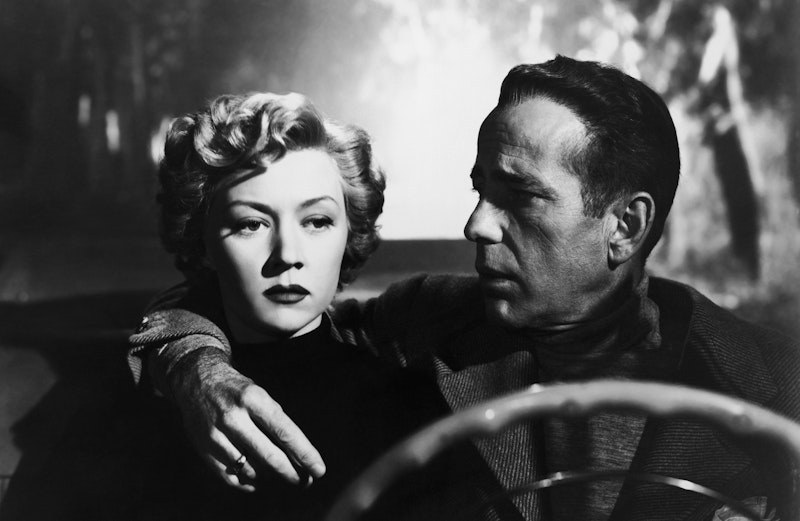Nicholas Ray’s In a Lonely Place (1950) stands out among other noir films. This isn’t a surprise: Ray’s vision often goes beyond genre and usual script expectations. It never follows a formula but a desire to enter into a character’s interior anguish and fragmented soul. Nothing’s idealized, and romance is always coupled by the harsh reality of life. For Ray, a character must embrace the inevitability of pain and suffering.E
The image of Humphrey Bogart has been stamped into the American consciousness, namely masculinity and indifference, yet perfectly capable of great love. We see Bogart moving from coldness to warmth to the final declaration of love. A man, whose cold masculinity gets in the way only to be changed by a woman. This isn’t true of his role in In a Lonely Place.
Bogart plays Dixon Steele, a Hollywood screenwriter who fights the inhumanity of the Hollywood machine, while dependent on it. He’s usually tasked with adapting books into scripts, and hasn’t had a success in a few years. He refuses to write “popcorn” movie scripts and yearns for a higher form of art. This attitude has made him volatile and disagreeable among his so-called colleagues and his agent. They put up with him and accept his outbursts as inevitable events.
Dix has been tasked to adapt a novel that he doesn’t particularly want to read. While at a restaurant, a hat-check girl, Mildred Atkinson, is enthralled by the same novel. Professing either laziness or self-importance, Dix asks Mildred to tell him the story of the novel so he doesn’t have to read it. Mildred agrees and, although slightly nervous at first (after all, she is invited to Dix’s place), she’s happy to help out.
Mildred’s straight-laced. She’s not interested in sexual innuendos. She asks for ginger ale with a twist of lemon, and keeps her encounter with Dix wholesome and professional. After the task has been completed, Mildred leaves. Dix’s gallantry was asleep at the time, and instead of taking her home or calling for a cab, he accepts Mildred’s decision to go to the cab stand by herself.
Things appear to be going fine for Dix, until an old army buddy (now a police detective), Brub Nicolai, calls on him early in the morning. He informs him that he needs to go to the police station: Mildred’s been found murdered and Dix is the primary suspect. Dix doesn’t take this seriously at all, and laughs it off.
Despite the great line of Hollywood “friends,” Dix is a lonely man with no alibi, until a beautiful woman, Laurel Gray (Gloria Grahame) who lives in the same apartment complex, provides a truthful alibi for him. She’s attracted to him, and Dix’s initial attraction to Laurel is borne purely out of self-centeredness. Laurel plays the femme fatale at the beginning of the film: she delivers typical noir one-liners, she plays hard to get, and one gets an impression that she has much to hide about her life. But then, Nicholas Ray takes the usual noir trope and turns it upside down.
Dix and Laurel become a couple enjoying their newfound domesticity. Laurel helps him and takes care of him so he can finish adapting the script. Dix has dug himself out of depression and it seems he can feel love again. The loneliness has exited the stage, and for the first time, Dix can breathe the air of love and compassion.
Still, something dark lies beneath. Brub and Captain Lochner keep pursuing him as the primary suspect, and Dix’s increasing frustration of being labeled as a murderer wears him down. His default position is anger and volatility. As the mental violence ascends, so does Laurel’s suspicion. Could he have murdered Mildred Atkinson? Is she the next victim? Or is she imagining everything?
In a Lonely Place is like a beautiful dream that’s punctuated by a nightmare. Ray creates a world dependent on solid objects and solid people. Bogart is rough and ugly; the cleaning lady always has a cigarette in the corner of her mouth as she’s trying to vacuum; even the phone and the clock impose their physicality. Yet it’s Grahame’s Laurel that brings a dreaminess into the fold. As her fear grows, her anguish becomes yearning for love. Her emotion takes on an ethereal quality and appears to be hovering above the apartment complex courtyard, a reminder for Dix on how brutish he is.
But is he? Who created him? Did he willingly choose to be a brute, a man who could’ve easily killed Mildred, and almost kills Laurel? Or did everyone around him create the brute by affirming suggestions of interior darkness?
Without a doubt, Dixon Steele is a tortured man. He’s perpetually in a lonely place, using indifference and humor to deflect from interior struggle. But the society that surrounds him fails to understand him, and in turn, he refuses to reveal his authentic self in order to be understood. Bogart transcends the art of acting. His performance as Steele comes from a spiritual place with winding paths of the self that wish to be hidden. It’s as if both Steele and Bogart simultaneously scream: “Leave me alone!” and in the same breath, “Please understand me!”
In a Lonely Place isn’t just a noir. It’s an existential tragedy that could’ve been written by Albert Camus. Borne out of post-war consciousness, the film delves into the unbearable burden of the self that oscillates between vitality and acedia. By the end of the film, Dix’s brokenness has nowhere to go but into the abyss. The possibility of being and love is always around the corner, but it’s out of the view for Dixon Steele.

